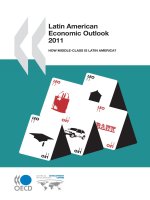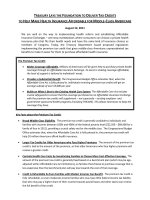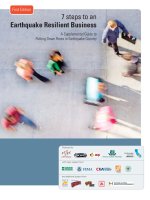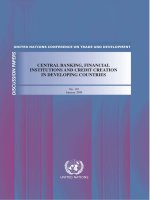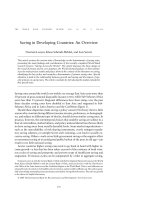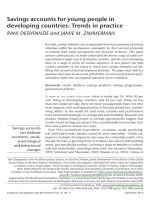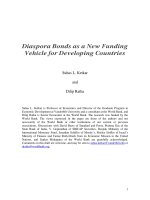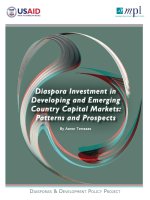New middle class in developing country
Bạn đang xem bản rút gọn của tài liệu. Xem và tải ngay bản đầy đủ của tài liệu tại đây (3.68 MB, 46 trang )
Discussion Paper
35/2014
A Cartography of the New
Middle Classes in Developing
and Emerging Countries
Clara Brandi
Max Büge
A cartography of the new middle classes in
developing and emerging countries
Clara Brandi
Max Büge
Bonn 2014
Discussion Paper / Deutsches Institut für Entwicklungspolitik
ISSN 1860-0441
Die deutsche Nationalbibliothek verzeichnet diese Publikation in der Deutschen Nationalbibliografie;
detaillierte bibliografische Daten sind im Internet über abrufbar.
The Deutsche Nationalbibliothek lists this publication in the Deutsche Nationalbibliografie; detailed
bibliographic data is available at .
ISBN 978-3-88985-661-6
Dr Clara Brandi, Researcher in the Department “World Economy and Development Financing” at the
German Development Institute / Deutsches Institut für Entwicklungspolitik (DIE).
E-mail:
Dr Max Büge, Gesellschaft für Internationale Zusammenarbeit (GIZ), Advisor, and German Development
Institute / Deutsches Institut für Entwicklungspolitik (DIE), Associate Researcher
E-mail:
© Deutsches Institut für Entwicklungspolitik gGmbH
Tulpenfeld 6, 53113 Bonn
+49 (0)228 94927-0
+49 (0)228 94927-130
E-Mail:
www.die-gdi.de
Abstract
The world is experiencing a structural change on an unprecedented scale: it is becoming
less poor and more middle-class. The growth of emerging middle classes has profound
implications for global development. Yet, although the emergence of middle classes
across the globe and its potential effects are set high on the agendas of researchers and
policy-makers, an often neglected fact is that middle-class characteristics vary greatly
from one country to another. Upon closer look, there is not one new global middle class
but a variety of very different burgeoning middle classes. This paper aims to highlight the
differences in middle-class growth, size and consumption capacities in developing and
emerging economies. To take account of this heterogeneousness, the paper presents a
novel middle-class typology that includes nine different “types” of middle classes, ranging
from small and affluent middle classes to large middle classes with low spending capacity.
The typology allows for comparing different middle classes across countries and is a
useful tool for more fine-grained research and policy analysis. Against that background,
the paper points to fruitful avenues for future research with regards to interpreting the role
of the rising middle classes in the context of economic growth, democracy and civic
values as well as environmental challenges.
Acknowledgements
The authors would like to thank Johannes Wegmann for his very helpful research
assistance and Kathrin Berensmann, Dominique Bruhn, Alejandro Guarín and Peter Wolff
for insightful comments.
The views and opinions expressed in this paper are those of the authors and do not
necessarily reflect the official policy or position of DIE or Deutsche Gesellschaft für
Internationale Zusammenarbeit.
Bonn, December 2014
Clara Brandi
Max Büge
Contents
Abbreviations
1
Introduction
1
2
How to define the middle class?
3
3
A cartography of the new middle classes
6
3.1
The geographic distribution of the world’s middle class
6
3.2
The size and spending capacity of today’s global middle class
7
3.3
The distribution and size of the middle class by country grouping
11
3.4
Comparing middle classes across different development levels
16
4
Proposing a new middle-class typology
20
5
Middle class heterogeneousness, economic growth, civic values and
environmental challenges – State of the debate and future avenues for
research
23
5.1
The middle class and inclusive growth
23
5.2
The middle class, democracy and civic values and attitudes
26
5.3
The middle class, environmental challenges and responsible consumption
28
6
Conclusion
30
Bibliography
31
Figures
Figure 1:
Joining the middle: Decade when a country (and the world)
is mostly middle class instead of mostly poor
2
Figure 2:
Self-perceived middle-class status and income in nine Asian countries
4
Figure 3:
Distribution of the global middle class (%), high-income vs. non-highincome countries
6
Figure 4:
Distribution of the global middle class (%), by region
7
Figure 5:
Middle-class population in millions of people and % of the population,
by region
8
Figure 6:
Figure 7:
Figure 8:
Figure 9:
Figure 10:
Figure 11:
Figure 12:
Figure 13:
Middle class in the BRICS, in millions of people (left) and % of
population (right), 1990–2010
12
Middle class in Turkey, Mexico, Iran and Egypt in millions of people
(left) and % of population (right), 1990–2010
13
Middle class in Bangladesh, Indonesia, Nigeria, Pakistan, Philippines,
Vietnam in millions of people (left) and % of population (right), 1990–
2010
14
Middle-class population in millions of people and % of the population,
selected sub-Saharan countries
15
Middle-class size (% of population) vs. GDP per capita (PPP US$),
2012
16
Difference between the true size of a middle class (as share of the
population) and the level suggested by the country’s GDP per capita
(US$), 2012
17
Middle-class consumption (annual average) vs. GDP per capita (US$),
2012
18
Difference between the true consumption of a middle class (annual
average) and the level suggested by the country’s GDP per capita
(US$), 2012
19
Boxes
Box 1:
The global middle class, population share: 1990, 2010, 2030
Box 2:
The global middle class, annual per capita consumption: 1990, 2010,
2030
10
Categorisation of middle classes by size and consumption capacity,
relative to economic development level
20
Box 4:
The case of South Korea vs. Brazil
25
Box 5:
Democracy, democratisation and the middle class
27
Box 3:
9
Abbreviations
BC
BRICS
COL
CHN
DAGI
DZA
EGY
GDP
IMF
MEX
OECD
PER
PPP
RWA
TUR
UK
UNU-WIDER
US
VNM
WBGU
ZAF
Before Christ
Brazil, Russia, India, China, South Africa
Colombia
China
Development, Aid and Governance Indicators (Brookings Institution)
Algeria
Egypt
Gross Domestic Product
International Monetary Fund
Mexico
Organisation for Economic Co-operation and Development
Peru
Purchasing Power Parity
Rwanda
Turkey
United Kingdom
United Nation University World Institute for Development Economics Research
United States
Vietnam
Wissenschaftlicher Beirat der Bundesregierung Globale Umweltveränderungen
South Africa
A cartography of the new middle classes in developing and emerging countries
1
Introduction
Until recently, the world’s middle classes were concentrated in industrialised, highincome countries. But this does not hold any longer. Whereas shrinking middle classes
with sometimes stagnating real incomes are increasingly becoming a policy concern in
many industrialised countries (Economist 2010; OECD 2011), developing and emerging
countries are seeing historical reductions in poverty rates1 and the rise of “new”,
“burgeoning” or “emerging” middle classes.2 Following two decades of developing
countries’ integration into global markets and their subsequent growth, the middle class
has become “global”, in the sense that it is geographically diverse now: from
approximately 2014 onwards, half of the world’s middle class will be situated in
developing and emerging countries. From around 2018 onwards, the world will be
predominantly middle class for the first time in history, and no longer predominantly poor.
Against the background of this overall trend, this paper asserts that these emerging middle
classes display very heterogeneous characteristics: there is not a new middle class, but a
variety of new middle classes.
Members of the new middle classes have the means to invest in health care, education and
financial services. They can afford to buy cars, housing, smartphones, durable consumer
goods as well as luxury brands. International and domestic companies cater to special
preferences and tastes of this market segment. Examples are numerous and include
Starbucks cafes that offers local flavours such as “Chestnut White Chocolate Mocha” or
“Peach Blossom Tea Latte” to its affluent customers in China, or Godrej & Boyce
Manufacturing – one of India’s oldest industrial companies – which successfully produces
and sells a US$ 70 battery-run fridge called “the little cool” (Economist 2010). Today,
middle-class consumption amounts to US$ 6.9 trillion annually in developing countries
alone (Court / Narasimhan 2014), which is more than the gross domestic products (GDPs)
of the UK, France and Spain combined.
But it is not only the consumption capacity of the new middle classes in developing and
emerging markets that matters. The middle class has always been associated with more
than its disposable income. Historically, it has been seen as a social class striving for
political, societal and economic liberties, as a guarantor of social stability and as pillar of
democracy. Already in 350 BC, the Greek philosopher Aristotle claimed in his magnum
opus Politics: “Thus it is manifest that the best political community is formed by citizens
of the middle class, and that those states are likely to be well-administered in which the
middle class is large, […] and where the middle class is large, there are least likely to be
factions and dissensions.” Similarly, today many observers are pinning their hope on the
burgeoning middle classes in Asia, Latin America and Africa as being gears for reform,
social progress and democratisation (e.g. Fletcher 2013). Thus, a closer look at the new
middle classes and their characteristics is warranted.
1
2
The share of people living on less than US$ 2 a day fell from 57 per cent of the world population in
1981 to 35 per cent in 2010 (World Bank 2014). In absolute terms, the number of people living in
poverty, measured at the US$ 2 threshold (2005 prices) fell from 2.59 billion people (1981) to 2.4
billion people (2010) (World Bank 2014).
As discussed in more detail below in Section 2, this paper defines the “middle class” as being
composed of people who dispose of a daily income of US$ 10–100 (2005 PPP US$) per day.
German Development Institute / Deutsches Institut für Entwicklungspolitik (DIE)
1
Clara Brandi / Max Büge
At the same time, middle-class dynamics in low- and middle-income countries are quite
diverse, and the middle classes in these countries can exhibit very different features. For
instance, in 2012, the middle class of India comprised 8 per cent of the country’s
population, and the combined middle class in sub-Saharan Africa comprised only around 2
per cent, whereas the middle class of China alone included more than 200 million people,
or 16 per cent of the population. As shown in this paper, the middle classes of Algeria and
Bangladesh are relatively small and have low spending capacity, even controlling for these
countries’ development levels, whereas the middle classes of Colombia, Rwanda and
Mexico are large and affluent, given the overall economic development of these countries.
Taking a look at the concept of a “middle-class country” – defined as a country that is mostly
middle class and not mostly poor – also illustrates this diversity. Although Cote d’Ivoire, Sri
Lanka and Indonesia are all lower-middle-income economies, Cote d’Ivoire has been a
middle-class country since the 1990s, Sri Lanka is currently becoming one and Indonesia will
only become a middle-class country next decade (Figure 1). Debates on the new global middle
class are thus misleading and should take this heterogeneousness into account.
Figure 1:
Joining the middle: Decade when a country (and the world) is mostly middle class
instead of mostly poor
1960s
Jamaica, Singapore
1970s
Malta, Taiwan, Cote d'Ivoire, Seychelles, South Korea
1980s
Costa Rica, Uruguay
1990s
Chile, Peru, Bosnia and Herzegovina, Albania, El Salvador
2000s
Russia, Malaysia, Belarus, Iran, Tunisia, Kazakhstan, Venezuela,
Ukraine, Dominican Republic, Brazil, Syria, Armenia,
Thailand, Colombia
2010s
World, Panama, Ecuador, Egypt, Turkmenistan, Georgia, Sri Lanka,
Botswana, Moldova, Paraguay, Gabon, Jordan, China
2020s
Indonesia, South Africa, India, Azerbaijan, Cambodia, Vietnam, Fiji,
Bangladesh, Philippines, Tajikistan, Uzbekistan, Guatemala, Morocco,
Sudan
Note: Poverty is defined as a daily income of US$ 5 (2005 US$ PPP) or less. Middle class is defined as a daily income of US$ 10–
100 (2005 US$ PPP). Only countries are listed that had more poor than middle-class citizens in the first year of the database
(1965). When the threshold is passed several times, the latest year is used.
Source:
Authors’ calculations; data from Kaufman, Kharas and Penciakova (2012)
The paper is structured as follows: it begins by presenting various definitions of the
middle class and explains and justifies the definition we are using in this paper (Section
2). In Section 3, the paper provides a cartography of the new middle classes, based upon
data from the Brookings Institution’s Development, Aid and Governance Indicators, in
2
German Development Institute / Deutsches Institut für Entwicklungspolitik (DIE)
A cartography of the new middle classes in developing and emerging countries
order to illustrate the differences across middle classes around the world and provide the
basis for a novel middle-class typology. We show how today’s global middle class is
composed in terms of geography and size; we then put a particular focus on countries that
belong to the BRICS (Brazil, Russia, India and China, South Africa), the “Next Ten”, and
sub-Saharan Africa – that is, country groups that are very heterogeneous in terms of their
composition, but that receive considerable attention in the context of debates on the world
economy and global development. We also assess the relationship between a country’s
GDP per capita and the share of the middle class in the total population as well as the
relationship between the spending capacity of the middle class and the respective
country’s level of economic development. In light of middle-class cartography set out in
Section 3, Section 4 proposes a novel middle-class typology that takes account of the size
and spending capacities of different types of middle classes. Section 5 suggests
implications of the heterogeneousness of middle classes around the world for future
avenues of research by pointing to research gaps in the context of the links between the
middle class and growth, values and attitudes as well as environmental awareness and
responsible consumption. Section 6, the last part of the paper, summarises the main
findings and provides concluding comments.
2
How to define the middle class?
There is no consensus on how to define the middle class. In empirical studies, two
approaches are in use: on the one hand, definitions that rely on individuals’ self-perceived
status and, on the other hand, those that rely on observable data based on, for instance,
income or consumption levels.
Self-perceived social status can be a meaningful measure to compare trends in a single
country over time. But since social self-perception is strongly embedded in its sociocultural context, it is a less appropriate measure for cross-country analyses. For instance,
Amoranto and colleagues have studied the link between income and self-perceived
middle-class status in Asia (Amoranto / Chun / Deolalikar 2010). They find, first, that the
correlation between self-perceived middle-class status and income is low and, second, that
strong differences across countries occur in this regard. This is shown in Figure 2. The
figure displays the self-perceived middle class (total=100%) of nine Asian countries, with
different colours indicating the respective income group (in quintiles of the country’s total
distribution). For instance, the light blue on the top of each column shows how much of a
country’s self-perceived middle class belongs to the top quintile of income distribution
(i.e. the 20 per cent of the population with the highest income). Those in the “middle” of
the income bracket (i.e. the median quintile) are shown in dark blue. Across countries,
strong differences appear. For instance, 57 per cent of the members of the (self-perceived)
middle class in Vietnam belong to this income group, but only 30 per cent in India; 5 per
cent of Thailand’s middle class, according to this definition, belong to the country’s top
earners, but only 1 per cent in China.
For this reason, the most common approach to identify the middle class is on the basis not
of self-perception but on the basis of levels of income or consumption, either in relative or
absolute terms. The relative approach defines the middle class on the basis of a middle
German Development Institute / Deutsches Institut für Entwicklungspolitik (DIE)
3
Clara Brandi / Max Büge
Figure 2:
Self-perceived middle-class status and income in nine Asian countries
100%
0%
90%
22%
1%
3%
15%
14%
4%
1%
3%
20%
37%
38%
53%
45%
44%
47%
40%
37%
22%
2%
9%
Bottom quintile
13%
2nd quintile
7%
57%
34%
13%
10%
40%
47%
41%
30%
Source:
37%
30%
50%
0%
2%
22%
37%
70%
20%
5%
31%
80%
60%
3%
9%
3%
Middle quintile
23%
15%
9%
0%
4th quintile
4%
4%
1%
Top quintile
Amoranto, Chun and Deolalikar (2010)
share of income or consumption relative to the rest of the population. For instance,
Birdsall and her colleagues Graham and Pettinato (2000) identify those belonging to the
middle class as having an income that amounts to 75 to 125 of the median income within
the country. Easterly (2001) identifies the three middle quintiles of the per capita
distribution of consumption within a country as being the middle class.
Yet, identifying the middle class on the basis of relative levels of income or consumption
is less appropriate for comparative cross-country studies, since it can mask substantial
differences between middle-class consumption capacities. We therefore opt for a
definition based on income in absolute terms and not relative to the rest of the country.
In order to identify the middle class on the basis of absolute levels of income or
consumption, different thresholds are used. For instance, a number of scholars use the low
threshold of US$ 2 per capita per day as the absolute lower bound of their definition of
persons who belong to the middle class, in order to distinguish them from the poor.
Banerjee and Duflo (2008) count those who spend US$ 2 to US$ 10 per capita per day as
being part of the middle class. Similarly, Ravallion (2009) uses the US$ 2 and the US$ 13
thresholds. The African Development Bank (2011) and the Asian Development Bank
(Chun 2010) utilise the US$ 2 threshold as well.
At the same time, various scholars and commentators caution against using a low
threshold of US$ 2 per day to define the middle class because income at this level does not
4
German Development Institute / Deutsches Institut für Entwicklungspolitik (DIE)
A cartography of the new middle classes in developing and emerging countries
safeguard economic security (e.g. Birdsall 2014; Donnan / Bland / Burn-Murdoch 2014).
Today, 40 per cent of the world population, or 2.8 billion people, live on US$ 2–10 a day
in 2005 purchasing power parity (PPP)3 terms, which is just above the World Bank’s
poverty threshold (Donnan / Bland / Burn-Murdoch 2014). The critics argue that the
middle class should be distinguished from this large group of people in developing and
emerging economies who are above the international poverty line but still vulnerable to
falling back into poverty, and therefore do not belong to the secure middle class. They can
be referred to as the “vulnerable”, the “strivers”, the “fragile middle” on a “slippery
ladder” (Donnan / Bland / Burn-Murdoch 2014) or the “strugglers” (Birdsall / Lustig /
Meyer 2013).
The “strugglers” do not suffer the hardships of extreme poverty as many of their fellow
citizens and can afford sufficient caloric intake, maybe a scooter or motorcycle, schooling
for their children, a mobile phone and can occasionally send remittances to their families
in rural areas. But their discretionary spending remains low and they can hardly put money
aside. Personal misfortune, a long drought or monsoon, or any other form of economic
shock can easily throw them back into poverty. For instance, survey results show that 55
per cent of the poor in Indonesia used to live above the poverty threshold a year before the
survey was done (Donnan / Bland / Burn-Murdoch 2014). They are not poor, but given
their income insecurity, correspondingly low levels of consumption and a lack of financial
stability, their lifestyle is not the one typically associated with the middle class (Birdsall /
Lustig / Meyer 2013).
In this paper, we therefore define the global middle class as being comprised of those
households with daily expenditures between US$ 10 and US$ 100 per person in PPP terms.
By using this definition, we follow Kharas (2010) and Kharas and Gertz (2010). The aim of
using these thresholds is to exclude those who are regarded as rich in the richest advanced
country (using twice the median income of Luxemburg) and those who are regarded as poor
in the poorest advanced countries (using as reference the average poverty lines in Portugal
and Italy, the two European countries with the strictest definitions of poverty) (Kharas /
Gertz 2010). Moreover, we use US$ 10 a day as the defining lower threshold in order to
distinguish members of the middle class from the “strugglers” who are at a substantial risk
of falling back into poverty. For Latin America, Lopez-Calva and Ortiz-Juarez (2011) show
that, at an income of around US$ 10 a day in PPP terms, people only have a 10 per cent
chance of falling back into poverty. They are thus sufficiently secure to consume, to be able
to save for the future and to have aspirations for a better life for themselves and their
children; their lifestyle is a middle-class one.
For quantitative information on the size and spending capacities of middle classes in the
Global South, we rely on the Development, Aid and Governance Indicators (DAGI) from
the Brookings Institution. The data is constructed by Daniel Kaufman, Homi Kharas and
Veronika Penciakova (2012) and based on country household surveys and information
derived from national accounts.4
3
4
The PPP base year in this text is always 2005 and 2011 for information on GDP per capita, except if
otherwise noted.
For data and methodology, see: />
German Development Institute / Deutsches Institut für Entwicklungspolitik (DIE)
5
Clarra Brandi / Maax Büge
3
A cartoggraphy of the new m
middle classses
3.1
The geoggraphic distribution oof the world
d’s middle class
The sppatial distriibution of world
w
incom
me has substtantially shiifted duringg the last deecades,
and thhis trend cann be expectted to continnue. If a geeographer in
n 1980 had plotted eco
onomic
activitty on a globe to identtify the poinnt that reprresents the mean-locatiion – the world’s
w
“economic centree of gravity
y” – in term
ms of production, thiss point wouuld unsurprisingly
have bbeen between Europe and the US
S, somewhere in the middle
m
of thee Atlantic. By
B the
late 20000s the saame undertaaking wouldd have led to a very different
d
ressult – the world’s
w
econoomic centre of gravity would havee shifted 4,8
800 km easstwards to a location close to
the Tuurkish city of
o Izmir, miirroring the increasing economic weight
w
of A
Asia. Extrapo
olating
growthh rates to 2050,
2
the prrojected gloobal econom
mic centre of
o gravity w
will move another
a
4,500 km further to the east – to a locatiion between
n India and China (Quaah 2011).
A carttography off the world
d’s middle-cclass populaations reflects this shiift. Until recently,
the woorld’s midddle class was predominnantly congrruent with rich, industrrialised nations: in
1990 three-fourthhs of the gllobal middl e class wass concentratted in high--income cou
untries
(by tooday’s standdards), whicch represennted a meree third of th
he world’s ppopulation at that
time. Since then, the world
d’s middle cclass has become
b
mucch more divverse in terrms of
geograaphy. From
m approxim
mately 2014 onwards, emerging and
a developping markets will
repressent more thhan half of the
t global m
middle classs. By 2020 these
t
countrries will rep
present
two-thhirds of the global midd
dle class annd more than
n three-fourrths by 20300 (Figure 3)).
Figurre 3:
Sourcce:
Distrib
bution of the global middlle class (%), high-income vs. non-high--income coun
ntries
Authors’ calculations; data from Kaaufman, Kharras and Penciaakova (2012)
Most oof the increeasing sharee of non-higgh-income countries
c
is driven
d
by SSouth Asia and
a the
East A
Asia and Paacific region
n. Both reggions represented, respeectively, lesss than 1 peer cent
and 2 per cent off the world’ss middle claass in 1990. Today, So
outh Asia acccounts for circa 5
per ceent of the gllobal middlle class andd the East Asia
A and Paccific region,, thanks to China,
roughly for 15 per cent. In 2030, each of these tw
wo regions will have m
more middle-class
citizenns than all of
o today’s high-income
h
e countries combined (Figure 4). The middle class
will allso expand in sub-Sahaaran Africa;; the Middlee East and North
N
Africca; Latin Am
merica;
and E
Europe andd Central Asia. But with low
wer growth rates andd less favo
ourable
demoggraphics, thhe share off these reggions that comprise
c
th
he global m
middle classs will
6
Germaan Developmeent Institute / Deutsches
D
Institut für Entw
wicklungspolitiik (DIE)
A cartoography of thee new middle classes
c
in devveloping and emerging
e
coun
ntries
increaase only at the margin
ns, or will even decliine in the cases
c
of Laatin Americca and
Europpe and Centrral Asia (Figure 4).
Figurre 4:
Sourcce:
3.2
Distrib
bution of the global middlle class (%), by region
Authors’ calculations; data from Kaaufman, Kharras and Penciaakova (2012)
The size and spending capacitty of today
y’s global middle
m
classs
In abssolute terms, the middlee class of higgh-income countries
c
(m
measured byy global stan
ndards)
includdes more thaan a billion people
p
todaay, representting roughly
y 90 per cennt of the citizzens in
these ccountries. This
T numberr still dwarfs
fs the count of middle-cclass citizenns in other reegions,
taken individuallyy: 246 milliion people iin the East Asia
A and Paacific regionn (less than 20 per
cent oof the nationnal populatio
on on averaage) are mid
ddle-class; 144 million in Eastern Europe
E
and Central Asia (47 per cen
nt); 276 milliion in Latin
n America (3
36 per cent)); 80 million
n in the
N
Africca (25 per ceent); and on
nly a tiny fraaction of thee population
n – less
Middlle East and North
than 1 per cent – in South Assia and sub-Saharan Afr
frica with, reespectively, 76 million and 31
mers. Thus, ssub-Saharan
n Africa com
mbined still has fewer middlem
millionn middle-cllass consum
class ccitizens todaay than Spaiin or South Korea alonee (Figure 5).
structural chhange in deeveloping an
Nonettheless, the underlying
u
nd emergingg countries is
i truly
remarkkable. The emerging middle
m
class grew by more
m
than haalf a billion people duriing the
last tw
wo decades.. As illustraated above, this trend is
i being pow
wered consiiderably by
y South
Asia aand the Eastt Asia and Pacific
P
regiion, which together
t
con
ntributed haalf of this nu
umber.
The m
middle classees in both reegions grew
w, starting fro
om very low
w levels, by a factor of 9 and a
factor of 13, respeectively, durring the 19990–2010 perriod, compaared to a fact
ctor of betweeen 1.8
gh-income rregions. In the
t future, th
he contributtion of Asiaa to the
and 3..4 for the otther non-hig
emergging middle class will even be higgher. By 20
030, an estiimated 2.3 billion out of 2.7
billionn new middlle-class con
nsumers in ddeveloping or
o emerging
g countries w
will be from
m Asia:
the em
merging midddle class off the last tw
wo decades has
h been glo
obal, but thee emerging middle
m
class oof the next two
t decadess will be moostly Asian.
A globbal overview
w and timeline are givven in Boxees 1 and 2. Box
B 1 show
ws the sharee of the
middle class as percentage of a counttry’s population, and Box 2 its aannual per capita
he years 19990, 2010 an
nd 2030. Daata is ordereed by quarttiles of
consum
mption cappacity for th
Germann Developmennt Institute / Deutsches
D
Insttitut für Entwiicklungspolitik
k (DIE)
7
Clara Brandi / Max Büge
the respective year.5 The maps underline that the rise of the middle classes is particularly
pronounced in many Asian countries.
Figure 5:
Middle-class population in millions of people and % of the population, by region
1400
100%
90%
1200
80%
1000
70%
60%
800
50%
600
40%
30%
400
20%
200
1990
2000
2010
2020
2030
1990
2000
2010
2020
2030
1990
2000
2010
2020
2030
1990
2000
2010
2020
2030
1990
2000
2010
2020
2030
1990
2000
2010
2020
2030
1990
2000
2010
2020
2030
0
10%
0%
East Asia &
Europe & High-income Latin America Middle East & South Asia Sub-Saharan
Pacific
Central Asia
countries & Caribbean North Africa
Africa
Middle-class population, mnl (left axis) Middle-class population, %
100%=1
(right axis)
(right axis)
Source:
Authors’ depiction; data from Kaufman, Kharas and Penciakova (2012)
The growth of the middle classes around the world is, evidently, a consequence of
increased income. Increased income, in turn, modifies consumption patterns, wherein
there is a shift from acquiring basic goods to buying discretionary goods. For example,
this becomes apparent in the context of food consumption: the share of income spent on
food goes systematically down as income rises (Engel’s law). Several studies illustrate
that consumption patterns in China, India and Brazil have considerably changed, with a
reduced proportion of expenditures being spent on food and more on housing, transport,
recreation, education, clothing and luxury goods (Beinhocker / Farrell / Zainulbhai 2007;
Calicchio / Francis / Ramsay 2007; Artigas / Calicchio 2007; Hansakul 2010).
Although the middle class is growing in most places, albeit at different paces, its
consumption capacity varies. For instance, the average middle-class consumer in Latin
America and the Caribbean has a budget that is circa 20 per cent higher than in subSaharan Africa and almost 40 per cent higher than in South Asia.
Next, we take a closer look at the countries of three different groups of emerging and
developing countries: the BRICS, the Next Ten and sub-Saharan Africa. Whereas each
category comprises very different countries in terms of the economy, the political system
and – with the exception of sub-Saharan Africa – the geographic region, each country
group is regularly studied in global development and economy analyses and each plays an
important role in the context of development policy.
5
Note that the four different colours in Box 1 and Box 2 depict the four quartiles respectively. Across
years, the same colour can, while referring to the same quartile, therefore refer to different percentage
shares or consumption levels.
8
German Development Institute / Deutsches Institut für Entwicklungspolitik (DIE)
A cartography of the new middle classes in developing and emerging countries
Box 1: The global middle class, population share: 1990, 2010, 2030
Percentage share of the middle class in population, by quartiles, 1990
0% - 3%
3% - 20%
20% - 81%
81% - 99%
No data
Percentage share of the middle class in population, by quartiles, 2010
0% - 4%
4% - 40%
40% - 89%
89% - 100%
No data
Percentage share of the middle class in population, by quartiles, 2030
0% - 22%
22% - 68%
68% - 87%
87% - 98%
No data
Source:
Authors’ depiction; data from Kaufman, Kharas and Penciakova (2012)
German Development Institute / Deutsches Institut für Entwicklungspolitik (DIE)
9
Clara Brandi / Max Büge
Box 2: The global middle class, annual per capita consumption: 1990, 2010, 2030
Average annual middle-class consumption (2005 US$ PPP), by quartiles, 1990
3,700$ - 6,100$
6,100$ - 7,100$
7,100$ - 9,000$
9,000$ - 19,600$
No data
Average annual middle-class consumption (2005 US$ PPP), by quartiles, 2010
3,700$ - 6,700$
6,700$ - 9,200$
9,200$ - 16,400$
16,400$ - 21,500$
No data
Average annual middle-class consumption (2005 US$ PPP), by quartiles, 2030
4,100$ - 6,300$
6,300$ - 7,800$
7,800$ - 11,800$
11,800$ - 19,800$
No data
Source:
10
Authors depiction; data from Kaufman, Kharas and Penciakova (2012)
German Development Institute / Deutsches Institut für Entwicklungspolitik (DIE)
A cartography of the new middle classes in developing and emerging countries
3.3
The distribution and size of the middle class by country grouping
The BRICS countries
The emerging middle class is often associated with the BRICS, the well-known acronym
coined by Goldman Sachs economist Jim O’Neill, standing for Brazil, Russia, India and
China, plus South Africa. And indeed, the potential market of middle-class consumers in these
countries more than quintupled, from US$ 451 billion6 in 1990 to US$ 2.43 trillion in 2010.
Yet, when it comes to the dynamics of their middle-class expansion, there are considerable
differences among these countries. Brazil, Russia and South Africa already had substantial
middle classes in the 1990s, representing 25 per cent or more of these countries’
populations. The middle classes in India and China, in contrast, represented only a tiny
fraction of the populations (less than 3 per cent) in the 1990s. Since then, most of the
BRICS countries have been able to substantially increase the share of their middle classes,
both in absolute numbers and relative to the overall population (Figure 6). Only South
Africa’s middle class did not expand considerably, relative to the rest of the population,
and even dropped in the early 2000s below the levels of the early 1990s. However, South
Africa has the most affluent middle class among the BRICS, with an average annual
consumption of circa US$ 10,000. This is considerably higher than in Russia (US$ 8,800),
Brazil (US$ 8,300), India (US$ 6,300) or China (US$ 6,100).
Among the BRICS, only Brazil and Russia are “middle-class countries”, which is defined
here as countries having more middle-class members than very poor ones.7 Thus, the term
“middle-class country” does not mean that these countries do not have to tackle important
problems of poverty or inequality but simply that the middle class is more populous than
the income group at the very bottom. In Russia, which has been classified as a highincome country by the World Bank since 2012, circa three-fourths of the population is
middle-class; since 2006, Brazil has more middle-class citizens than poor citizens.
On the opposite end, China and India today are still far from being labelled middle-class
countries – a fact that is sometimes forgotten in current debates about the emerging middle
classes. The share of the middle class in both nations is well below 20 per cent (12 per cent
in China and only 5 per cent in India, in 2010), and thus lower than levels in the other
BRICS countries more than two decades ago. It is estimated that China will only join the
ranks of middle-class countries in 2018 and India in 2021. In addition, and as shown above,
average middle-class spending is lowest among those citizens living in the BRICS countries.
However, given the gigantic sizes of their populations, the middle classes of India and
particularly China already outnumber those of most industrialised nations. In 2010, more
than 60 million people were middle-class in India and almost 160 million in China (Figure
6). When the world’s countries are ranked by the size of their middle class, China comes
second (after the US) and India eighth. This is particularly impressive given that two
decades earlier, India’s middle classes had fewer than 6 million citizens and China’s
middle class fewer than 1.5 million citizens, which corresponds roughly to the sizes of the
middle-classes in Bulgaria and Bangladesh today. Furthermore, both nations will be the
middle-class powerhouses of tomorrow, with more than an estimated 590 million (China)
and 280 million (India) middle-class consumers by 2020.
6
7
2005 US$ in PPP terms.
Below the US$ 5 a day poverty line.
German Development Institute / Deutsches Institut für Entwicklungspolitik (DIE)
11
Clara Brandi / Max Büge
Middle class in the BRICS, in millions of people (left) and % of population (right),
1990–2010
country = Brazil
country = India
100
country = South Africa
50
country = China
country = Russia
0
Middle Class (million people)
150
Figure 6:
1995
2000
Year
2005
2010
60
country = Brazil
country = India
country = South Africa
20
40
country = China
country = Russia
0
Middle Class (% of population)
80
1990
1990
Source:
1995
2000
Year
2005
2010
Authors’ depiction; data from Kaufman, Kharas and Penciakova (2012)
The Next Ten
The Next Ten is a group of countries that comprises nations with very different levels of
GDP per capita – varying between low-income status and OECD membership – and thus
with very different development challenges. Yet, what these countries have in common is
that, given their demographics and economic growth rates, they will be amongst the world’s
largest economies within the next decades. The following paragraphs highlight the major
trends and characteristics of the middle classes in the Next Ten, namely Bangladesh, Egypt,
Indonesia, Iran, Mexico, Nigeria, Pakistan, Philippines, Turkey and Vietnam.8
Broadly speaking, the Next Ten can be differentiated into three categories: first, current
middle-class countries (Turkey, Mexico, Egypt and Iran); second, aspiring middle-class
countries (Bangladesh, Indonesia, Philippines, Vietnam); and third, countries with middle
classes that make up only a small share of the population but are still substantial in absolute
numbers (Nigeria and Pakistan).
8
12
A Goldman Sachs report (Wilson / Stupnytska 2007) drew attention to the “Next Eleven”, a fastprospering group of countries other than the BRICS countries, including South Korea. We describe in
the following the countries belonging to this group. However, since Korea has been a middle-class
country since 1979 and a high-income country since 1995, we ignore it here.
German Development Institute / Deutsches Institut für Entwicklungspolitik (DIE)
A cartography of the new middle classes in developing and emerging countries
Middle class in Turkey, Mexico, Iran and Egypt in millions of people (left) and % of
population (right), 1990–2010
60
country = Egypt
country = Mexico
20
40
country = Iran
country = Turkey
0
Middle Class (million people)
80
Figure 7:
1995
2000
Year
2005
2010
Middle Class (% of population)
20
40
60
80
1990
country = Egypt
country = Mexico
0
country = Iran
country = Turkey
1990
Source:
1995
2000
Year
2005
2010
Authors’ depiction; data from Kaufman, Kharas and Penciakova (2012)
Turkey and Mexico have been middle-class countries for a long time now. The middle
class in both countries – three-fourths and two-thirds of the population, respectively –
reflects the presence of a vivid civil society with affluent consumers (per capita
consumption ca. US$ 9,0009). The middle classes in Iran and Egypt are smaller – circa 50
per cent and 25 per cent of the population, respectively – and have a lower consumption
capacity (ca. US$ 7,000 and US$ 6,00010) but they have grown considerably (by a factor
of 4) in both countries during the last two decades (Figure 7). Iran has had a higher share
of middle-class citizens than poor ones in its population since 2002, and Egypt since 2012.
Arguably, this growth of the middle class has resulted not only in changing economic
circumstances but it has also accentuated political preferences in both countries. Important
examples of this are Iran’s demonstrations following the re-election of Mahmoud
Ahmadinejad in 2009 and the revolution against and overthrow of Husni Mubarak in
Egypt in 2011 (e.g. Graham / Chattopadhyay 2014).
The “aspiring middle-class countries” have small middle classes today, but these have the
potential to rapidly expand. In particular, Indonesia is noteworthy: its middle class
9
10
2005 US$ in PPP terms.
Idem.
German Development Institute / Deutsches Institut für Entwicklungspolitik (DIE)
13
Clara Brandi / Max Büge
skyrocketed from 1 per cent of the population in 1990 (2.5 million people) to more than 13
per cent (30.8 million people) in 2010, a level similar to the one in the Philippines
(Figure 8). In the 2020s, the middle class in each country will be larger than the number of
very poor citizens there, and the same holds for Bangladesh and Vietnam (Figure 8). The
latter two countries have a very small middle class today (1 per cent and 5 per cent of the
population, respectively), but the extrapolation of previous growth rates promises a rapid
expansion of the “aspiring middle class” in the two decades to come.
Middle class in Bangladesh, Indonesia, Nigeria, Pakistan, Philippines, Vietnam in
millions of people (left) and % of population (right), 1990–2010
20
country = Bangladesh
country = Nigeria
country = Philippines
10
country = Indonesia
country = Pakistan
country = Vietnam
0
Middle Class (million people)
30
Figure 8:
1995
2000
Year
2005
2010
25
20
country = Bangladesh
country = Nigeria
country = Philippines
5
10
15
country = Indonesia
country = Pakistan
country = Vietnam
0
Middle Class (% of population)
30
1990
1990
Source:
1995
2000
Year
2005
2010
Authors’ depiction; data from Kaufman, Kharas and Penciakova (2012)
In contrast, Nigeria and Pakistan will, in the foreseeable future, continue to have more
poor people than middle-class citizens. However, due to the sizes of these countries, they
will have a substantial middle class, even if the country overall remains poor. Currently,
the middle class in each country amounts to 4 per cent of the population, or somewhat
more than 6 million people in each country.
Sub-Saharan Africa
From a global economic perspective, sub-Saharan Africa barely registers. The last time the
region contributed more than 2 per cent of world GDP was 1983 (World Bank 2014). It is
more often associated with poverty, and often conflict, than with economic success.
However, economic success does exist and sub-Saharan Africa has been experiencing a
14
German Development Institute / Deutsches Institut für Entwicklungspolitik (DIE)
